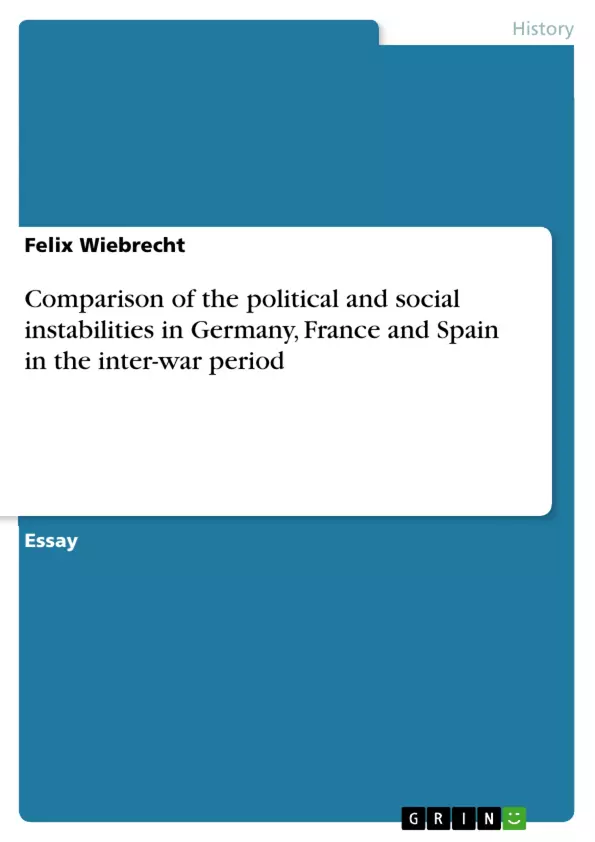Compared and contrasted political and social instabilities in the inter-war period between Germany, France and Spain.
Inhaltsverzeichnis (Table of Contents)
- Introduction
- Germany
- The Weimar Republic
- Political Instabilities
- France
- Political Instabilities
- Short-Living Governments
- Spain
- The Turno System
- Political Instability
- The Dictatorship of General Primo de Rivera
- Social Unrest
- Strikes, Riots and Street Fights
- The Influence of the Bolshevik Revolution
Zielsetzung und Themenschwerpunkte (Objectives and Key Themes)
This text aims to analyze and compare the political and social instabilities that characterized Germany, France, and Spain during the inter-war period. It examines the factors that contributed to this instability, focusing on the challenges faced by these nations in the aftermath of World War I. Key themes explored in this analysis include:- Political Instabilities
- Governmental Instability
- Coalition Formation and Failure
- Social Unrest and Violence
- The Influence of External Events
Zusammenfassung der Kapitel (Chapter Summaries)
This text begins by establishing the context of the inter-war period, highlighting the profound changes that occurred in Europe following World War I, including the rise of new political systems and the decline of empires. The analysis then focuses on Germany, examining the establishment of the Weimar Republic and the numerous challenges it faced, particularly in maintaining political stability. The text highlights the instability of coalition governments, the rise of totalitarian parties, and the increasing influence of the Reichspräsident. The discussion then shifts to France, where a similar pattern of political instability is observed. The text discusses the various coalitions that formed and dissolved, the impact of the economic crisis, and the difficulty in finding solutions to the challenges facing the country. The text concludes its analysis with Spain, examining the transition from the Turno system to a multi-party system, the rise and fall of General Primo de Rivera's dictatorship, and the growing social unrest that ultimately led to the outbreak of the Civil War. The final section of the text focuses on the widespread social unrest that characterized all three countries during the inter-war period, highlighting the role of strikes, riots, and street fights in expressing discontent.Schlüsselwörter (Keywords)
This text explores the inter-war period in Europe, focusing on the political and social instabilities of Germany, France, and Spain. Key terms and concepts include: Weimar Republic, political instability, coalition governments, totalitarian parties, social unrest, strikes, riots, and the influence of the Bolshevik Revolution.
Excerpt out of 9 pages
- scroll top
- Quote paper
- Felix Wiebrecht (Author), 2012, Comparison of the political and social instabilities in Germany, France and Spain in the inter-war period, Munich, GRIN Verlag, https://www.grin.com/document/207392
Look inside the ebook



